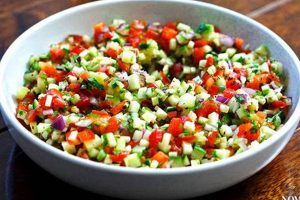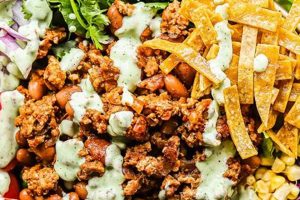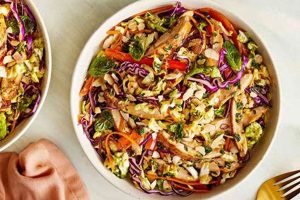Fast and simple salads offer convenient meal solutions for individuals with busy schedules or those seeking light, refreshing dishes. These recipes typically involve minimal preparation time and readily available ingredients, often emphasizing fresh produce, pre-cooked proteins, and easy-to-make dressings. Examples include a chopped salad with grilled chicken, a Caprese salad with mozzarella, tomato, and basil, or a simple green salad with vinaigrette.
Salads aligned with this concept contribute to healthy eating habits by providing essential vitamins, minerals, and fiber, while often being lower in calories and fat compared to heavier meals. Historically, salads have evolved from simple combinations of raw greens to complex culinary creations, with the increasing demand for quick preparations reflecting modern lifestyles and dietary preferences. This demand has led to innovative approaches in ingredient combinations, pre-packaged salad kits, and readily available pre-cooked components.
This article will further explore various aspects of salads that are both quick and easy to prepare, encompassing tips for ingredient selection, dressing preparation, and creative salad combinations. It will also address nutritional considerations and offer guidance on creating satisfying and flavorful salads tailored to individual preferences.
Tips for Quick & Easy Salad Preparation
Efficient salad preparation relies on strategic planning and ingredient selection. The following tips offer guidance for creating nutritious and flavorful salads with minimal time and effort.
Tip 1: Embrace Pre-washed Greens. Utilizing pre-washed and pre-cut lettuce or spinach significantly reduces preparation time. These convenient options allow for immediate assembly and eliminate the need for washing and chopping.
Tip 2: Utilize Pre-cooked Proteins. Rotisserie chicken, canned tuna or salmon, hard-boiled eggs, and pre-cooked lentils or beans offer convenient protein sources that require no additional cooking.
Tip 3: Incorporate Canned or Frozen Vegetables. Canned corn, beans, or artichoke hearts, as well as frozen peas or edamame, provide quick and easy additions to enhance flavor and nutritional value.
Tip 4: Prepare Simple Vinaigrettes. Whisk together olive oil, vinegar, and seasonings for a quick and customizable dressing. Experiment with different vinegar types and herbs for variety.
Tip 5: Embrace Chopped Salads. Chopping all ingredients into bite-sized pieces allows for even distribution of flavors and facilitates easier consumption.
Tip 6: Utilize Leftovers. Cooked grains, roasted vegetables, or grilled meats can be repurposed into flavorful salad additions, minimizing food waste and maximizing efficiency.
Tip 7: Invest in a Salad Spinner. This tool efficiently dries greens, preventing soggy salads and ensuring crisp texture.
By implementing these strategies, individuals can create healthy and satisfying salads efficiently, promoting healthful eating habits without extensive time commitments in the kitchen.
These tips offer a foundation for crafting quick and easy salads, paving the way for a deeper exploration of recipe variations and customization options in the following sections.
1. Fresh, Readily Available Ingredients
The foundation of quick and easy salad recipes lies in the accessibility and quality of ingredients. Utilizing fresh, readily available components streamlines the preparation process and contributes to the overall flavor and nutritional value of the salad. This emphasis on readily available ingredients aligns with the core concept of minimizing preparation time and effort.
- Seasonal Produce
Choosing produce that is in season ensures optimal flavor and freshness while often being more readily available and affordable. Farmers’ markets and local grocery stores are excellent sources for seasonal fruits and vegetables. Incorporating seasonal ingredients allows for creative variations and maximizes nutritional benefits. Examples include ripe tomatoes in summer, crisp apples in autumn, or vibrant citrus fruits in winter.
- Pantry Staples
Maintaining a well-stocked pantry with items like canned beans, olives, nuts, seeds, and dried fruits provides convenient and readily available components for quick salad assembly. These ingredients offer extended shelf life, ensuring access to essential nutrients and flavor enhancements throughout the year.
- Pre-Prepared Ingredients
Utilizing pre-washed greens, pre-cut vegetables, or pre-cooked proteins significantly reduces preparation time. While these options might involve slightly higher costs, the time saved often justifies the convenience, especially for those with busy schedules. Pre-cooked grilled chicken or roasted vegetables can elevate a simple salad with minimal effort.
- Herbs and Spices
Fresh or dried herbs and spices significantly enhance the flavor profile of a salad. Maintaining a selection of commonly used herbs like basil, oregano, or mint, along with spices such as cumin or paprika, allows for quick and easy flavor customization.
By focusing on readily available, fresh ingredients, individuals can create nutritious and flavorful salads efficiently, aligning with the core principles of quick and easy meal preparation. This approach promotes healthy eating habits without sacrificing flavor or convenience, contributing to a sustainable and enjoyable dietary approach.
2. Minimal preparation time
Minimal preparation time represents a crucial element of quick and easy salad recipes. The time investment required directly influences the practicality and appeal of these recipes, particularly for individuals with busy schedules or limited culinary experience. A direct correlation exists: reduced preparation translates directly into increased convenience, making healthy eating a more attainable goal. For instance, opting for pre-washed and chopped lettuce eliminates the need for washing, drying, and chopping, saving valuable time. Similarly, utilizing pre-cooked proteins such as grilled chicken or canned beans bypasses the need for cooking and reduces overall preparation time significantly.
The importance of minimal preparation time extends beyond mere convenience. It also contributes to the preservation of nutrient content in fresh ingredients. Lengthy preparation processes can expose delicate vitamins and minerals to oxidation and degradation, potentially diminishing the nutritional value of the salad. Quick preparation techniques, on the other hand, minimize this risk, ensuring that the salad retains its maximum nutritional benefits. Consider a salad composed of pre-washed spinach, cherry tomatoes, pre-cooked shrimp, and a simple lemon vinaigrette. This combination requires minimal preparation, maximizing both convenience and nutritional integrity.
Understanding the significance of minimal preparation time allows for strategic recipe development and ingredient selection. Prioritizing techniques and components that streamline the process contributes to the overall success and appeal of quick and easy salad recipes. This focus facilitates consistent adoption of healthy eating habits by removing a common barrier time constraints. Ultimately, minimizing preparation time empowers individuals to prioritize fresh, nutritious meals without compromising their busy schedules.
3. Simple dressings
Simple dressings play a crucial role in achieving the speed and convenience characteristic of quick and easy salad recipes. The preparation time for a dressing significantly impacts the overall time investment in creating a salad. Complex dressings requiring multiple ingredients and steps can negate the time-saving benefits of using pre-prepared salad components. Conversely, simple dressings, often composed of just a few readily available ingredients, contribute directly to the efficiency of the overall recipe. A basic vinaigrette, for example, requires only oil, vinegar, and seasonings, taking mere minutes to prepare. This efficiency directly supports the goal of minimizing time spent in the kitchen. Furthermore, simple dressings often enhance, rather than mask, the natural flavors of the fresh ingredients in the salad, aligning with the emphasis on fresh, high-quality produce.
The versatility of simple dressings further contributes to their value in quick and easy salad recipes. A basic vinaigrette can be easily adapted with variations in the type of oil or vinegar, the addition of herbs, or the inclusion of a touch of sweetness. This adaptability allows for customization without significantly increasing preparation time. For example, a lemon vinaigrette can be transformed into a honey-lemon vinaigrette with the simple addition of a teaspoon of honey. This versatility extends the usability of basic dressings across a wide range of salad combinations, promoting variety and reducing the need for multiple specialized dressings. This approach aligns with the practical, efficient nature of quick and easy meal preparation.
Simple dressings represent a critical component of quick and easy salad recipes, contributing directly to the speed, convenience, and adaptability of these dishes. Their ease of preparation and versatility allows for a diverse range of flavor profiles without compromising the core principles of minimal time investment and readily available ingredients. An understanding of this connection facilitates efficient and enjoyable meal preparation, contributing to the integration of healthy eating habits into even the busiest lifestyles.
4. Pre-cooked or no-cook components
Pre-cooked or no-cook components represent a cornerstone of quick and easy salad recipes. Their utilization significantly streamlines the preparation process, aligning directly with the demand for minimal time investment. Incorporating these components reduces or eliminates cooking time, a major factor contributing to overall efficiency in the kitchen. This approach facilitates healthy eating habits by removing a common barrier the perceived lack of time for meal preparation.
- Proteins
Pre-cooked proteins, such as grilled chicken, roasted tofu, canned tuna or salmon, hard-boiled eggs, or pre-cooked lentils, offer substantial nutritional value and flavor without requiring any additional cooking. Adding these directly to a salad drastically reduces preparation time. For example, incorporating leftover grilled chicken from a previous meal transforms a simple green salad into a complete protein-rich meal within minutes.
- Grains
Pre-cooked grains, such as quinoa, rice, or couscous, contribute complex carbohydrates and texture to salads without necessitating cooking time during salad preparation. These can be prepared in batches ahead of time and stored for convenient use throughout the week. Adding pre-cooked quinoa to a salad with roasted vegetables creates a hearty and satisfying meal with minimal effort.
- Vegetables
While many vegetables are enjoyed raw in salads, certain vegetables benefit from pre-cooking, particularly for enhancing flavor or digestibility. Roasted vegetables, such as sweet potatoes, Brussels sprouts, or broccoli, add depth and complexity to salads. Pre-cooking these components beforehand allows for quick assembly when desired.
- Legumes
Canned legumes, such as chickpeas, black beans, or kidney beans, offer a convenient and protein-rich addition to salads. Requiring no cooking, they contribute valuable fiber and nutrients while streamlining the preparation process. Adding canned chickpeas to a salad with chopped cucumber, tomatoes, and a lemon vinaigrette creates a refreshing and nutritious meal in minutes.
The strategic incorporation of pre-cooked or no-cook components forms the basis of efficient and convenient salad preparation. This approach simplifies the process, reduces time investment, and promotes healthy eating habits by making nutritious meals readily accessible. By strategically utilizing these components, individuals can create a wide variety of flavorful and satisfying salads without lengthy cooking or complex preparation steps, reinforcing the core principles of quick and easy meal solutions.
5. Versatile, Adaptable Recipes
Versatility and adaptability represent essential characteristics of recipes designed for quick and easy salad preparation. These qualities directly address variations in ingredient availability, dietary preferences, and individual tastes. A versatile salad recipe functions as a template, allowing for substitutions and modifications without compromising the fundamental structure of the dish. This adaptability proves particularly valuable in situations where specific ingredients might be unavailable or undesirable. For example, a recipe calling for spinach can easily accommodate kale or romaine lettuce as substitutes, maintaining the core concept of a leafy green salad while accommodating preference or availability. Similarly, a protein component like grilled chicken can be readily replaced with tofu, chickpeas, or hard-boiled eggs, catering to diverse dietary needs without necessitating a completely new recipe. This adaptability contributes significantly to the practicality and sustainability of quick and easy salad preparation.
The practical significance of versatile, adaptable salad recipes becomes apparent in various real-life scenarios. Consider a situation where a planned grocery shopping trip is delayed or shortened. With an adaptable salad recipe, available ingredients can be substituted seamlessly, preventing disruptions to meal plans. This flexibility reduces reliance on strict adherence to a recipe, promoting resourcefulness and minimizing food waste. Furthermore, adaptable recipes cater to evolving dietary preferences within a household. A single base recipe can be modified to create vegetarian, vegan, or gluten-free variations, accommodating individual needs without requiring separate preparation efforts. This inclusivity enhances the practicality of quick and easy salads as a regular meal option.
In conclusion, the versatility and adaptability of quick and easy salad recipes directly contribute to their practicality, sustainability, and inclusivity. These qualities empower individuals to navigate variations in ingredient availability, dietary preferences, and personal tastes without compromising the speed and convenience that define these recipes. This understanding facilitates the consistent integration of healthy, satisfying salads into diverse lifestyles, promoting balanced nutrition and culinary enjoyment. Furthermore, this adaptability fosters creativity and experimentation in the kitchen, encouraging exploration of flavor combinations and personalized variations within the framework of quick and easy meal preparation.
6. Nutritious and Flavorful Combinations
Nutritious and flavorful combinations represent a critical aspect of quick and easy salad recipes. The nutritional value of a salad directly impacts its contribution to a healthy diet, while flavor influences palatability and enjoyment. Balancing these two aspects ensures that salads serve as both a convenient and healthful meal option. This balance is particularly relevant in quick and easy recipes, where the emphasis on speed and simplicity must not compromise nutritional value or sensory appeal.
- Nutrient Density
Prioritizing nutrient-dense ingredients maximizes the health benefits of a salad within the constraints of quick preparation. Ingredients like leafy greens, colorful vegetables, lean proteins, and healthy fats contribute essential vitamins, minerals, fiber, and antioxidants. For example, combining spinach, bell peppers, grilled chicken, and avocado creates a salad rich in vitamins A, C, and K, as well as protein and healthy fats. This focus on nutrient density ensures that even quickly prepared salads contribute significantly to overall dietary needs.
- Flavor Balancing
Strategic flavor combinations enhance the palatability of salads, making them more enjoyable and promoting consistent consumption. Balancing contrasting flavors, such as sweet and savory, or acidic and creamy, creates a more complex and satisfying sensory experience. A salad combining roasted sweet potatoes, tangy goat cheese, and peppery arugula exemplifies this principle. The interplay of flavors elevates the salad beyond a simple combination of ingredients, promoting enjoyment and encouraging healthy eating habits.
- Textural Variety
Varying textures within a salad contributes to a more engaging and satisfying eating experience. Incorporating crunchy elements like nuts or seeds, creamy components like avocado or cheese, and tender greens creates a dynamic textural profile. A salad with mixed greens, roasted chickpeas, chopped cucumber, and crumbled feta cheese offers a diverse range of textures, enhancing enjoyment and preventing monotony. This attention to texture elevates even simple salads, making them more appealing and enjoyable.
- Seasonal Considerations
Utilizing seasonal ingredients maximizes flavor and nutritional value while aligning with the principles of quick and easy preparation. Seasonal produce tends to be readily available and requires minimal processing, contributing to both speed and nutritional integrity. A summer salad featuring ripe tomatoes, fresh basil, and mozzarella exemplifies this approach. The inherent flavors of peak-season ingredients require minimal enhancement, allowing for quick preparation and maximum enjoyment.
The interplay of these elementsnutrient density, flavor balancing, textural variety, and seasonal considerationsunderpins the creation of quick, easy, and satisfying salads that contribute meaningfully to a healthy and enjoyable diet. Understanding these connections allows for strategic ingredient selection and recipe development, ensuring that even the simplest salads deliver optimal nutritional value and sensory appeal. This approach reinforces the practicality and sustainability of incorporating quick and easy salads into regular meal planning, promoting long-term health and well-being.
7. Easy Cleanup
Easy cleanup represents a significant advantage of quick and easy salad recipes, contributing to their overall convenience and appeal. Minimizing post-meal cleanup aligns directly with the time-saving objective inherent in these recipes. The efficiency of preparation extends beyond the actual creation of the salad to encompass the entire meal process, from start to finish. Reduced cleanup time enhances the practicality of these recipes, particularly for individuals with busy schedules or those seeking to minimize kitchen workload.
- Minimal Cooking Equipment
Quick and easy salad recipes often involve minimal or no cooking, reducing the number of pots, pans, and utensils requiring washing. This reliance on fresh, pre-cooked, or no-cook components simplifies the cleanup process significantly. A salad composed primarily of raw vegetables, canned beans, and a simple vinaigrette requires only a cutting board, knife, and mixing bowl, minimizing the number of items needing washing. This streamlined approach contributes directly to the overall efficiency and convenience of the meal.
- One-Bowl Meals
Many quick and easy salads can be assembled and served in a single bowl, reducing the number of dishes used and simplifying cleanup. This “one-bowl” approach minimizes dishwashing and streamlines the entire meal process. A chopped salad, for instance, can be prepared, dressed, and served in the same bowl, maximizing efficiency and minimizing post-meal cleanup.
- Easy-to-Clean Ingredients
The ingredients commonly used in quick and easy salad recipes often contribute to simplified cleanup. Fresh produce typically requires minimal rinsing, while pre-cooked or canned components eliminate the need for scrubbing pots and pans. Using ingredients like pre-washed greens further streamlines the process. This focus on easy-to-clean ingredients contributes to the overall efficiency of the meal, from preparation to cleanup.
- Quick Disassembly
The simple composition of quick and easy salads facilitates quick disassembly and disposal of any remaining ingredients or waste. With fewer components and minimal cooking involved, leftover ingredients can often be stored easily or composted, further minimizing cleanup time and effort. This efficient approach to post-meal management contributes to the overall convenience and practicality of these recipes.
The ease of cleanup associated with quick and easy salad recipes reinforces their value as a convenient and practical meal solution. By minimizing post-meal tasks, these recipes enhance their overall appeal and contribute to a more streamlined and enjoyable cooking experience. This efficiency aligns directly with the core principles of time-saving and simplified meal preparation, promoting the integration of healthy eating habits into busy lifestyles without adding to kitchen workload. Easy cleanup contributes significantly to the sustainable adoption of quick and easy salads as a regular dietary component.
Frequently Asked Questions
This section addresses common inquiries regarding the preparation and enjoyment of quick and easy salads.
Question 1: How can salads be made more filling without sacrificing their quick and easy nature?
Adding protein and healthy fats increases satiety. Incorporating pre-cooked grilled chicken, fish, beans, lentils, nuts, seeds, or avocado enhances a salad’s ability to satisfy hunger without requiring extensive preparation.
Question 2: What strategies can be employed to prevent salads from becoming soggy?
Thoroughly drying greens after washing and storing dressings separately until serving prevents sogginess. Using a salad spinner effectively removes excess moisture from greens. Adding croutons or crunchy toppings immediately before serving also helps maintain crispness.
Question 3: How can variety be achieved when prioritizing speed and simplicity in salad preparation?
Utilizing a variety of seasonal vegetables, fruits, proteins, and dressings prevents monotony. Rotating ingredients based on availability and personal preferences ensures diverse flavors and textures, while maintaining the ease of quick preparation. Exploring different cuisines can also inspire creative salad combinations.
Question 4: Are quick and easy salads truly nutritious?
Nutrient content depends directly on ingredient selection. Prioritizing fresh produce, lean proteins, and healthy fats ensures a nutritionally balanced meal. Incorporating a variety of colorful vegetables maximizes vitamin and mineral intake. Limiting processed ingredients and unhealthy fats further enhances nutritional value.
Question 5: How can one minimize food waste when preparing salads regularly?
Proper storage of ingredients and utilizing leftovers creatively minimizes waste. Storing greens in airtight containers with paper towels helps maintain freshness. Leftover cooked grains, proteins, or roasted vegetables can be incorporated into subsequent salads, reducing waste and maximizing resource utilization.
Question 6: What are some convenient options for salad dressings when aiming for quick preparation?
Simple vinaigrettes made with oil, vinegar, and seasonings offer convenient and customizable options. Pre-made dressings, while less customizable, provide a quick solution. However, opting for low-sodium and minimally processed varieties is recommended to maximize health benefits.
Understanding these common concerns facilitates successful integration of quick and easy salads into a healthy and convenient dietary approach.
For further exploration of specific recipe ideas and variations, please continue to the next section.
Conclusion
Quick and easy salad recipes offer a practical and efficient approach to incorporating fresh, nutritious meals into busy lifestyles. Strategic utilization of pre-prepared ingredients, simple dressings, and no-cook components minimizes preparation time without compromising flavor or nutritional value. The adaptability of these recipes allows for customization based on individual preferences, dietary needs, and ingredient availability. Focusing on nutrient-dense components and balanced flavor profiles ensures that these salads contribute meaningfully to a healthy and enjoyable diet. Furthermore, the ease of cleanup associated with these recipes enhances their overall convenience and reinforces their practicality as a sustainable dietary choice.
The increasing demand for convenient, healthy meal options underscores the significance of quick and easy salad recipes. These recipes represent a valuable tool for promoting healthy eating habits within the constraints of modern life. Continued exploration and innovation within this culinary approach promise further enhancements in convenience, flavor, and nutritional value, contributing to a more sustainable and enjoyable approach to healthy eating for individuals seeking efficient and nutritious meal solutions.






